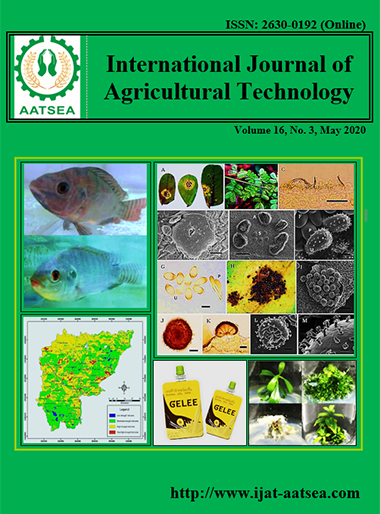Two new records of Ravenelia species on legumes in Thailand
Main Article Content
Abstract
Ravenelia species were found in legume plants (family Fabaceae) in Thailand. Ravenelia stevensii occurred on Pterolobium macropterumin Lampang and Khonkean provinces, and Ravenelia neocaledoniensis on Vachellia farnesiana in NakhonPathom province. They produced different sporulation stages and spore morphology on their hosts. Ravenelia stevensii produced spore stages including spermogonial, aecial, uredinial and telial stages in the same host (P. marcopterum). Ravenelia stevensii have prominently appendages on teliospore surface and its structure size was very closely to voucher specimens. The rust fungus, R. neocaledoniensis was found only uredinial stage on V. farnesiana. The species were identified confirmation bymorphology and phylogenetic analysis using 28S rDNA. The results showed that R. neocaledoniensis was grouped together with the sequence obtained from GenBank database. The four squences of R. stevensii were clustered and separated from others Ravenelia species with 100% bootstrap value supporting. These rustfungi and host taxa were reported as a new record not only in Thailand but also in Southeast Asia.
Article Details

This work is licensed under a Creative Commons Attribution-NonCommercial-NoDerivatives 4.0 International License.
References
Arthur, J. C. (1915). Uredinales of Perto Rico, base on collection by F.L. Stevens. Mycologia, 7:168-196, 315-332.
Arthur, J. C. (1917). Uredinales of Perto Rico, base on collection by Whetzel, H. H. and Olive, E. W. Mycologia, 55:104-9.
Baxter, J. W. (1966). New records of North American rust fungi. Mycologia, 58:971-973.
Berndt, R. (2002). New species, reports and observations on rust fungi. Nova Hedwigia, 75:415-431.
Cummins, G. B. (1978). Rust fungi on legumes and composites in North America. University of Arizona Press, Tucson,pp.424.
Ebinghaus, M. and Beferow, D. (2018). Ravenelia piepenbringiae and Ravenelia hernandezii, two new rust species on Senegalia (Fabaceae, Mimosoideae) from Panama and Costa Rica. MycoKeys, 51:41-63.
Engkhaninun, J., Chatasiri, S., To-anun, C., Visarathanonth, N., Kakishima, M. and Ono, Y. (2005). New geographical distribution and host records of rust fungi from northern Thailand.Mycoscience, 46:137-142.
Farr, D. F. and Rossman, A. Y. (2019). Fungal Databases, U.S. National Fungus Collections, ARS, USDA.Retrieved October 9, Retrieve from https://nt.ars-grin.gov/fungaldatabases/
Felsenstein, J. (1985). Confidence limits on phylogenies: An approach using the bootstrap. Evolution, 39:783-791.
Gandhe, K. R. and Kuvalekar, A. (2007). Phylogenetic studies in Ravenelia esculenta and related rust fungi. Indian Journal of Microbiology, 47:212-218.
Gallegos, M. L. and Cummins, G. B. (1981). Uredinales (royas) de Mexico, Vol. 2. InstitutoNacional de InvestigacionesAgricoles, Culiaca Sinaloa, Mexico, pp.492.
Huguenin, B. (1966a). Micromycètes du PacifiqueSud. (Cinquième contribution). Urédinales.de Nouvelle-Calédonie (I). Bulletin trimestriel de la Sociétémycologique de France, 82:263-266.
Huguenin, B. (1966b). Micromycetes de Nouvelle-Caledonie. InCah. ORSTOM., Ser. Biol., 1:61-91.
Kumar, S., Stecher, G. and Tamura, K. (2016). MEGA7: Molecular Evolutionary Genetics Analysis version 7.0 for bigger datasets. Molecular Biology and Evolution, 33:1870-1874.
Lohsomboon, P., Kakishima, M., Ono, Y., Manoch, L. and Visarathanonth, N. (1988). Materials for the rust flora in Thailand II. Transactions of the Mycological Society of Japan, 29:225-234.
McTaggart, A. R., Doungsa-ard, C., Wingfield, M. J. and Roux, J. (2015). Uromycladiumacaciae, the cause of a sudden, severe disease epidemic on Acacia mearnsii in South Africa.Australasian Plant Pathology, 44:637-645.
Mouchacca, J. and Horak, E. (1998). Annotated checklist of New Caledonian Basidiomycota.II. Rusts and Smuts. Mycotaxon, 69:13-30.
Nei, M. and Kumar, S. (2000). Molecular Evolution and Phylogenetics. Oxford University Press, New York.
Pardo-Cardona, V. M. (1998). Registrosnuevospara la flora de Uredinales (royas) de Colombia. Revista de la Academia Colombiana de Ciencias, 22:347-354.
Porter, T. M. and Golding, G. B. (2012). Factors that affect large subunit ribosomal dnaamplicon sequencing studies of fungal communities: Classification Method, Primer Choice, and Error. Plos One, 7:e35749.
Saitou, N. and Nei, M. (1987). The neighbor-joining method: A new method for reconstructing phylogenetic trees. Molecular Biology and Evolution, 4:406-425.
Shivas, R. G., Beasley, D. R. and McTaggart, A. R. (2014). Online identification guides for Australian smut fungi (Ustilaginomycotina) and rust fungi (Pucciniales). IMA Fungus 5:195–202. Retrieved from http://collections.daff.gld.gov.au/web/key/rustfungi/Media /Html/raveneliaindigoferae.html.
Smitinand, T. and Larsen, K., eds. (1984). Flora of Thailand (Vol.4: 1). Bangkok: TISTR Press.
Smitinand, T. and Larsen, K. (1985). Flora of Thailand (Vol.4:2). Bangkok. TISTR Press.
Stevenson, J.A. (1975). Fungi of Puerto Rico and the American Virgin Islands.Contr. Reed Herb, 23:743.
Walker, J. (1983). Pacific mycogeography: Deficiencies and irregularities in the distribution of plant parasitic fungi. Australian Journal of Botany Supplementary Series, 13:89-136.


